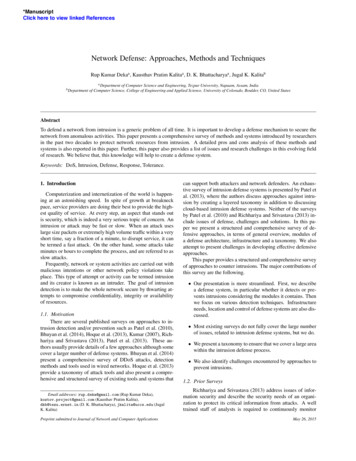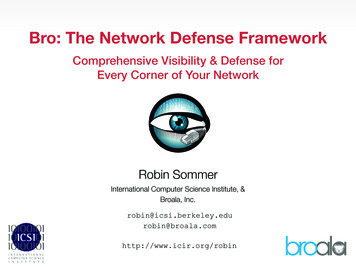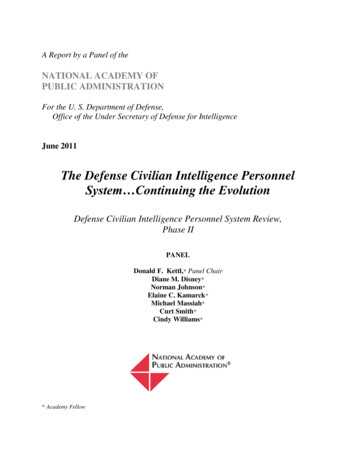
Transcription
*ManuscriptClick here to view linked ReferencesNetwork Defense: Approaches, Methods and TechniquesRup Kumar Dekaa , Kausthav Pratim Kalitaa , D. K. Bhattacharyaa , Jugal K. Kalitabb Departmenta Department of Computer Science and Engineering, Tezpur University, Napaam, Assam, Indiaof Computer Science, College of Engineering and Applied Science, University of Colorado, Boulder, CO, United StatesAbstractTo defend a network from intrusion is a generic problem of all time. It is important to develop a defense mechanism to secure thenetwork from anomalous activities. This paper presents a comprehensive survey of methods and systems introduced by researchersin the past two decades to protect network resources from intrusion. A detailed pros and cons analysis of these methods andsystems is also reported in this paper. Further, this paper also provides a list of issues and research challenges in this evolving fieldof research. We believe that, this knowledge will help to create a defense system.Keywords: DoS, Intrusion, Defense, Response, Tolerance.1. IntroductionComputerization and internetization of the world is happening at an astonishing speed. In spite of growth at breakneckpace, service providers are doing their best to provide the highest quality of service. At every step, an aspect that stands outis security, which is indeed a very serious topic of concern. Anintrusion or attack may be fast or slow. When an attack useslarge size packets or extremely high volume traffic within a veryshort time, say a fraction of a minute, to disrupt service, it canbe termed a fast attack. On the other hand, some attacks takeminutes or hours to complete the process, and are referred to asslow attacks.Frequently, network or system activities are carried out withmalicious intentions or other network policy violations takeplace. This type of attempt or activity can be termed intrusionand its creator is known as an intruder. The goal of intrusiondetection is to make the whole network secure by thwarting attempts to compromise confidentiality, integrity or availabilityof resources.1.1. MotivationThere are several published surveys on approaches to intrusion detection and/or prevention such as Patel et al. (2010),Bhuyan et al. (2014), Hoque et al. (2013), Kumar (2007), Richhariya and Srivastava (2013), Patel et al. (2013). These authors usually provide details of a few approaches although somecover a larger number of defense systems. Bhuyan et al. (2014)present a comprehensive survey of DDoS attacks, detectionmethods and tools used in wired networks. Hoque et al. (2013)provide a taxonomy of attack tools and also present a comprehensive and structured survey of existing tools and systems thatEmail addresses: rup.deka@gmail.com (Rup Kumar Deka),koztov.project@gmail.com (Kausthav Pratim Kalita),dkb@tezu.ernet.in (D. K. Bhattacharya), jkalita@uccs.edu (JugalK. Kalita)Preprint submitted to Journal of Network and Computer Applicationscan support both attackers and network defenders. An exhaustive survey of intrusion defense systems is presented by Patel etal. (2013), where the authors discuss approaches against intrusion by creating a layered taxonomy in addition to discussingcloud-based intrusion defense systems. Neither of the surveysby Patel et al. (2010) and Richhariya and Srivastava (2013) include issues of defense, challenges and solutions. In this paper we present a structured and comprehensive survey of defensive approaches, in terms of general overview, modules ofa defense architecture, infrastructure and a taxonomy. We alsoattempt to present challenges in developing e ective defensiveapproaches.This paper provides a structured and comprehensive surveyof approaches to counter intrusions. The major contributions ofthis survey are the following. Our presentation is more streamlined. First, we describea defense system, in particular whether it detects or prevents intrusions considering the modules it contains. Thenwe focus on various detection techniques. Infrastructureneeds, location and control of defense systems are also discussed. Most existing surveys do not fully cover the large numberof issues, related to intrusion defense systems, but we do. We present a taxonomy to ensure that we cover a large areawithin the intrusion defense process. We also identify challenges encountered by approaches toprevent intrusions.1.2. Prior SurveysRichhariya and Srivastava (2013) address issues of information security and describe the security needs of an organization to protect its critical information from attacks. A welltrained sta of analysts is required to continuously monitorMay 26, 2015
Table 1: Comparison with Existing SurveysReferencesIDSIPSBai and Kobayashi (2003)Murali (2005)Kabiri and Ghorbani (2005)Kumar (2007)Patel et al. (2010)Sandhu et al. (2011)Rathore (2012)Patel et al. (2013)Richhariya and Srivastava (2013)Bhuyan et al. (2014)This esYesYesNoNoYesthe system. In such an environment, a huge amount of effort is required to construct new security strategies. Patel etal. (2010) review current trends in intrusion detection togetherwith a study of implemented technologies. Kabiri and Ghorbani (2005) identify main categories of intrusion detection andprevention systems. They also provide a comparison of variousapproaches. Rathore (2012) also provides a survey of di erentapproaches to intrusion detection. Sandhu et al. (2011) reviewsmethods for building Intrusion Detection and Prevention Systems (IDPS) and uses a cost-e ective intrusion detection andprevention method based on the concept of intelligent mobileagents to design an e ective Agent based Intrusion PreventionSystem (AIPS). AIPS works well in a distributed environmentdue to the use of software agents.Murali (2005) surveys recent IDPSs and alarm managementtechniques by providing a comprehensive taxonomy and investigating possible solutions to detect and prevent intrusions incloud computing systems. Considering the desired characteristics of IDPSs and cloud computing systems, a list of requirements is identified and four concepts of autonomic computing,viz., self-management, ontology, risk management, and fuzzytheory are leveraged to satisfy these requirements.A survey of technologies for defense against intrusion isgiven in Patel et al. (2013). This paper discusses aspects ofintrusion defense systems and data collection techniques. Datamining-based and data fusion-based IDSs are discussed to emphasize the need for large-scale data collection. Current defensetechnologies face powerful challenges and these are also described here, along with some suggested methods to overcomethem.Bai and Kobayashi (2003) describe detailed designs of bothsignature and anomaly-based NIDS (Network based IntrusionDetection System). Requirements of such systems are thoroughly discussed. Kumar (2007) presents a nomenclature ofIDSs that he uses for his survey. This paper also identifiesstrengths as well as the limitations of several IDSs.Our survey di ers from these previous surveys in the following ways. In all the papers mentioned in this section, there is littleDi nsechallengesNoNoNoNoNoNoNoYesNoYesYesinformation regarding where to deploy IDSs and other details of issues in deployment of IDSs. Most papers, which are mentioned in this section, do notprovide any discussion of challenges faced when an intrusion defense system is deployed. We describe modules of an intrusion defense model in thispaper. A thorough understanding of these modules is necessary to develop successful defense systems. Such discussions are not usually found in other survey papers.1.3. OrganizationThe rest of the paper is organized as follows. Concepts related to approaches and intrusion defense systems are discussedin Section 2. This section also presents a classification of intrusion detection, prevention, response and tolerance systems. Aselection of such systems is presented in Section 3. Section 4 isdedicated to issues and challenges in building a defense system.Finally, we present conclusions in Section 5.2. Intrusion Defense SolutionsWe can visualize three di erent types of attack which arementioned below.In Scanning attack, an attacker tries to gather informationsuch as network topology, types of network traffic allowed bythe firewalls, versions of operating system and kernel hosted ona network and identities and versions of server software running. The whole process may be initiated and accomplished bysending a stealth SYN packet. It is stealthy because the attackerjust tries to create a half open TCP connection. When the serverreceives a SYN packet, server responds with a SYN/ACK andgoes to a listening state, allowing the attacker to gather the required information. If no SYN/ACK is received by the attacker,it is assumed that the server is in a closed state.In a penetration attack, an attacker tries to access a systemand its resources without authorization. The attacker seeks toacquire the privileges of root to execute code easily and exploitsystem resources. After compromising the system, the attacker2
can use the machine as a launchpad for di erent types of attacks.A Denial of Service (DoS) attack tries to exhaust the resources of a network or a system. An attack can be carried outby a few malformed packets that exploit vulnerabilities in thehost or by a vast number of legitimate packets that exhaust thevictim’s network bandwidth or resources (Bhattacharya et al.,2013). As a precursor, a distributed DoS attacker may accessmany machines to lunch a coordinated distributed DoS attack.A DoS attack causes frequent congestion, hindering legitimatecommunication.With the rapid emergence of external and internal threatsto networks and resources, we must think about security all thetime. As a result, researchers and practitioners have looked ata variety of approaches such as Intrusion Detection Systems(IDS), Intrusion Prevention Systems (IPS), Intrusion ResponseSystem (IRS) and Intrusion Tolerance System (ITS). IPS andIDS are important components of a layered security infrastructure.Four main steps (Bhattacharya et al., 2013) taken by an attacker prior to executing an intrusion into a network or systemare as follows.violations. Some systems or approaches may try to stop an intrusion attempt, but this is neither required nor expected of amonitoring system. If an IDS detects any threat, it alerts thesystem or network administrator. The objective of an IDS is todetect and inform active defenders about intrusions. An IDSalso uses techniques that can detect abnormalities both at thenetwork and host levels. Figure 1 shows a generic view of anIDS. The components are: a managing system, a monitoringcomponent and a detection component. The managing system oversees traffic flow in the network.It provides traffic information to the monitoring component for analysis. The monitoring component monitors traffic and analyzesthe behavior of the network. The detection component detects any suspicious behaviorwith respect to the normal working nature of the network.If any abnormal behavior is detected, it is communicatedto the reaction component. The reaction component reacts to the situation. After detection of abnormality, it raises an alarm so that the intrusion can be handled appropriately.(a) Prepare: In this first step, the attacker attempts to collect network configuration information using port scannersto identify vulnerabilities in the network (Bhuyan et al.,2011). Port scanning gathers information such as computer IP addresses, operating systems, open ports withidentities and version of listening software.(b) Exploit: Once vulnerabilities are identified, in the secondstep, the attacker attempts to exploit these vulnerabilities.The attacker may execute multiple attempts during thisstep.(c) Leave Behind: If the lunching of an attack is successful,the attacker installs additional software to create continued access to the network. This process, termed as leavebehind, includes installation of network sni ers or additional back-door network services.Figure 1: Intrusion Detection System: A Generic View(d) Clean Up: At last, the attacker tries to clean up any evidence left due to the actions in the previous steps. This stepmay include restarting daemons crashed during the secondstep, clearing logs and other information, and installingmodified system software designed to override the presence of other software from normal system commands.2.1. Based on Approach UsedFigure 2: Intrusion Prevention System: A Generic ViewBased on the approach used to counter intrusions the fourmain intrusion defense systems such as: intrusion detection systems, intrusion prevention systems, intrusion response systemsand intrusion tolerance systems are found to work as follows.2.1.2. Intrusion Prevention SystemAn IPS is considered an upgraded version of an intrusion detection system (Desai, 2009). They both monitor network traffic and/or system activities for malicious activity, but the maindi erence is that intrusion prevention systems are able to actively prevent intrusions that are detected. An IPS executes2.1.1. Intrusion Detection SystemAn intrusion detection system (IDS) (Ertoz et al., 2004)monitors a network or system for malicious activities or policy3
steps such as sending an alarm, dropping malicious packets, resetting the connection and/or blocking traffic from the o endingIP addresses. Figure 2 presents a generic view of an intrusionprevention system. The managing system, monitoring component and detection component are similar to those in an IDS, butin the reaction component prevention procedures are applied bythe prevention engine.against malicious attacks. In lieu of the general aim of preventing all intrusions, intrusion tolerance uses mechanisms thatprevent intrusions from leading to system security failure. As amatter of fact, intrusion tolerance is not a new concept. Classical fault tolerance techniques are useful for tolerating intrusion and error detection and recovery. Error hiding techniquescan also be applied to provide data integrity or service availability despite intrusions. However, such fault-tolerance techniques are usually considered harmful for data confidentialitydue to the redundancy that they imply. Figure 4 provides ageneric view of an intrusion tolerance system. The managingsystem, the monitoring component and the detection component are similar to those in an IDS, but the reaction componentuses tolerance techniques. In the reaction component, the prevention engine appliesprocedures according to the pattern of behavior of the suspicious traffic by working closely with the Managing system. The managing system manages the traffic flow and appliesthe procedures provided by prevention engine. In the reaction component, intrusion tolerance techniquestry to prevent intrusions from causing system failure. The monitoring system and the detection component worksimilarly to those in an IDS. Classical techniques may be useful and efficient.2.1.3. Intrusion Response SystemAn intrusion response system (IRS) (Stakhanova et al.,1991) continuously monitors system health based on IDS alerts,so that malicious or unauthorized activities can be handled effectively by applying appropriate actions to prevent problemsfrom worsening the situation and to return the system to ahealthy mode. A notification system generates alerts when anattack is detected. An alert can contain information like attackdescription, time of attack, source IP and user accounts usedto attack. An IRS automatically executes a preconfigured setof response actions based on the type of attack. An automatedapproach requires no human intervention, unlike an IDS wherethere is a delay between intrusion detection and response. Figure 3 shows the generic structure of an intrusion response system. It is comprised of a reaction component, a detection component, a monitoring component and a managing system. Inparticular, A tolerance approach di ers from the conventional way ofpreventing the attacks.Figure 4: Intrusion Tolerance System: A Generic View2.2. Modules of A Defense SystemIn this section, we discuss the components of a generic defense system. The reaction component has a response system, and It responds to the intrusion using a predefined approach inan automated manner.2.2.1. MonitoringNetwork monitoring collects data on the state of the network(Conorich, 2004). Traffic analysis requires inspection of services being used on a network or system and comparing themagainst activities that are expected. This allows one to identifysuspicious services within a network. To perform basic network monitoring, one needs to collect traffic characteristics atvarious points within the network. Although it is necessary tolook carefully at network borders, if there are internal hosts providing unauthorized services for other internal hosts, one willmiss this traffic if one only looks at the borders. There are fourdi erent types of TCP activity that should be considered.Figure 3: Intrusion Response System: A generic View Are three-way handshakes being completely executed ornot?2.1.4. Intrusion Tolerance SystemAn Intrusion tolerance system (Deswarte et al., 1991) takesa fault-tolerant design approach to defend information systems Are three-way handshakes being initiated but never successfully completed?4
Is a client getting any response to a connection attempt?The client often does two or three retries with slight delaysamong them in case of failure.single attack into a single meta-alert is aggregation. Thetask of clustering alerts into incidents is called correlation(Julisch, 2003). Is a client getting any negative response to a connectionattempt, for example, a TCP RST packet or an ICMP hostunreachable or port unreachable packet?To prevent an attack before damaging the network system,it is need to adopt preventive measure like, creating a databaseof detected signatures of abnormalities to filter out threateningpackets, analyze pattern of network behavior, reconfigure othersecurity controls etc. Trace-backing (Xiang and Zhou, 2004)the source of attack is a good way to prevent the attack in future. But, it also important to look for low collateral damagewhile trace backing a huge botnet attack. So, reaction procedure in terms of prevention is suitable aspect. Passive systemscan attempt to terminate the connection before an attack cansucceed, for example, by ending an existing TCP session.Researcher have demonstrated that no system can assure todetect and prevent from any kind of anomalous activities in aexposed and live network in a generic way. Thus, the solutionto react, lead in two di erent track. One option is that, respondthe attack or intrusion in an efficient way to provide the usualservice to general user and stop the service to the non-legitimateuser. Second option is to provide fault tolerance approach towards attack.2.2.2. DetectionA detection module provides reports (Mukherjee et al., 1994)to a management section . Some detection modules may try tostop an attack but this is neither required nor expected. Theintrusion detection module is primarily focused on identifyingpossible incidents, logging information about them and reporting intrusion attempts. A detection module can be used forvarious purposes such as identifying problems with securitypolicies, documenting existing threats and deterring individualsfrom violating security policies. A detection module acquiresand analyzes information from various areas within a computeror a network to identify possible security breaches, vulnerabilities, which include both intrusions and misuse. This modulemay use scanning, which is a technology developed to assesssecurity vulnerabilities of a computer system or network.2.3. Based on Nature of Control2.2.3. ReactionTypically, a defense system reacts using a two-step process.The first set of procedures constituting the passive component,involves inspection of the system’s configuration files to detectinadvisable settings, inspection of the password files to detectinadvisable passwords, and inspection of other system areas todetect policy violations. The second set of procedures constitute the active component. Here mechanisms are set in placeto react to known methods of attack and to generate systemresponses. IDSs can respond to suspicious events in severalways, which include displaying an alert, logging the event oreven paging an administrator. Alarm management can be categorized into two (Klüft and Staaf, 2012; Pietraszek and Tanner,2005).In this section, we discuss types of defense systems basedon the control structure used to counter attack traffic. Thereare three basic ways used to control detection and preventionprocesses, viz., centralized, hierarchical and distributed (Patelet al., 2013).2.3.1. CentralizedIn this type of defense, each detection element producesalerts locally. The generated alerts are sent to a central serverthat plays the role of a correlation handler and analyzes them.Using centralized control, an accurate detection decision can bemade based on all available alert information. The main drawback of this approach is that the central unit is crucially vulnerable; any failure in the central server leads to the collapse ofthe whole process of correlation. In addition, the central unitshould be able to handle the high volume of data which it mayreceive from the local detection elements in a short amount oftime. Alert/alarm quality improvement: This approach tries toimprove alert quality by using information such as vulnerability reports or alert contexts. One can prioritize alertswith respect to the vulnerabilities of the victims.2.3.2. HierarchicalThe whole system is divided into several small groups basedon features such as geography, administrative control, and software platforms. The IDPSs at the lowest level work as detectionelements while an IDPS at a higher level is furnished with botha detection element and a correlation handler, and it correlatesalerts from both its own level and lower levels. The correlatedalerts are then passed to a higher level for further analysis. Thisapproach is more scalable than the centralized approach, butstill su ers from the vulnerability of the central unit. Besides,the higher level nodes have a higher level abstraction of the input, which may limit their detection coverage. Alarm correlation: This approach creates a more ambitious goal. It tries to reconstruct higher-level incidentsfrom lower-level alerts. Sometimes, a defense system maygenerate more alarms than normal within a short period. Ifa set of alerts are triggered, and knowing this without anyadditional background knowledge, one cannot determinewhether these are coordinated/distributed attacks or independent attacks that happen to be interleaved. If it is a single multistage attack, alarms would have to be generatedin a single incident. In the case of multiple attacks, thealerts should be divided into multiple incidents, namely,one incident per attack. Grouping alerts that constitute a5
Table 2: Comparison of Control Mechanisms for Defense Against tages- Each IDPS acts as a detection element.- Every detection element produces alerts locally.- The central unit is crucially vulnerable.- Any failure in the central server leads to deactivation of the whole process of correlation.- The central unit handles high volume of data received from local detection elements.- Accurate detection decisions can be made basedon all available alert information.DistributedHierarchical- Need not have complete information of networktopology.- Possible to have a more scalable design sincethere is no central entity.- Local alarm correlation is simpler in this structure.- This approach is more scalable than the centralized approach.- Higher level nodes have higher level abstractionsof the input.- Information about all alerts is not available during decision making about detection.- Alert information may be too narrow to detectlarge scale attacks.- Su ers from the vulnerability of a central unit.- At each level, the detection coverage may be limited.tems with distributed management control. All participatingIDPSs have their own components communicating with eachother. The advantages of the fully distributed IDPS (Leitneret al., 2007) are that although the network entities do not havecomplete information about the network topology, it is possible to have a scalable design since there is no central entityresponsible for doing all the correlation work, and local alarmcorrelation is simpler in this structure. Meanwhile, the fully distributed approach has its own drawbacks (Zhou et al., 2010): (a)Information on all alerts is not available during decision making, so the accuracy may be reduced; (b) The alert informationusually has a single feature (like an IP address), which may betoo narrow to detect large scale attacks.Figure 5: Central Management StructureFigure 7: Distributed Management StructureFigure 6: Hierarchical Management StructureLooking at the di erent approaches to control we observethe following.2.3.3. DistributedIn this approach, there is no centralized coordinator to process the information, and is comprised of fully autonomous sys- Each of the three ways of control has advantages and disadvantages. We summarize them in Table 2.6
Table 3: Comparison Between Host-based and Network-based hs- It is good in detecting and verifying inside attacks as they reside on host.- It is able to decrypt encrypted packets in incoming traffic.- There is no need for additional hardware.- It is designed to work in large networks.- It is usually passive and can be easily deployedon an existing network with no disruption to thenormal network operation.- It is less susceptible to direct attack. Depending on the network under consideration we may beable to choose any one among them for defense.Limitations- They are vulnerable to both direct attacks andattacks against host operating system.- They are vulnerable to denial of service attacks.- Performance overhead may increase.- Due to large network size, there is chance thatthe system fails to recognize attacks.- They cannot analyze packets which are encrypted.- Whether the attack is successful or not may notbe reliably detected.occurs, it triggers an alarm and passes the message to the central computer system or an administrator, and generates an automatic response. In hierarchical and distributed defense, every level can detect attacks and react accordingly in its own neighborhood.Each level or each unit usually handles a low volume ofdata.2.5. Defense LocationAn intrusion defense system can be deployed in three possible locations: victim-end, intermediate and source-end. Eachhas its advantages and disadvantages. In centralized defense, only the central server takes part inthe decision making process. The server covers the entirenetwork with no redundancy.2.5.1. Victim-end defense mechanismVictim-end detection (Douligeris and Mitrokotsa, 2004) approaches are conventionally employed in the routers of the victim side network. The detection software stores informationabout known intrusion signatures or profiles of normal behavior. This information is updated by the processing elements asnew knowledge becomes available. The processing element ina detection engine frequently stores intermediate results in whatis called configuration data. Detecting attacks at the victim endis relatively easy, but requires higher resource consumption. Animportant drawback is that these approaches detect the attackonly after it reaches the victim and thus legitimate clients havealready been a ected.2.4. Based on Defense InfrastructureIn this section, we discuss various defense systems based onthe infrastructure used. These are two basic types, viz., hostbased and network-based.2.4.1. Host-basedIn this architecture, data is analyzed by individual computersthat serve as hosts. The network architecture used is agentbased, which means that a software agent resides on each of thehosts in the system. Thus, a host-based Intrusion Detection andPrevention System (HIDPS) processes data that originates onthe computers themselves, such as event and kernel logs. AnHIDPS (Yeung and Ding, 2003) can also monitor which program accesses which resources and may flag anomalous usage.An HIDPS also monitors the state of the system and makes surethat everything makes sense, which is necessary for the use ofanomaly filters.2.5.2. Intermediate network defense mechanismThe intermediate network defense scheme (Wang et al.,2001) balances detection accuracy and attack bandwidth consumption, which are the main issues in source-end and victimend detection approaches. The main difficulty with this approach is deployability. To achieve full detection, all routerson the Internet will have to use this detection scheme, becausenon-availability of this scheme on only a few routers may causedetection failure. Thus, full practical implementation of thisscheme is extremely difficult.2.4.2. Network-basedA network based detection system examines data exchangedamong computers in the network. A Network-based IntrusionDetection and Prevention System (NIDPS) (Vigna et al., 2004)captures network traffic from the wire as it travels to a host.This can be analyzed for a particular signature or for unusual orabnormal behaviors. Several sensors are used to sni packetson the network; these are computer systems designed to monitor network traffic. If any suspicious or anomalous behavior2.5.3. Source-end defense mechanismThis type is somewhat similar to victim-end detection. It isthe best option if we want to reliably detect or stop intrusion(Mirkovic and Reiher, 2005). It prevents congestion not onlyon t
tems, intrusion prevention systems, intrusion response systems and intrusion tolerance systems are found to work as follows. 2.1.1. Intrusion Detection System An intrusion detection system (IDS) (Ertoz et al., 2004) monitors a network or system for malicious activities or policy violations. Some systems or approaches may try to stop an in-










